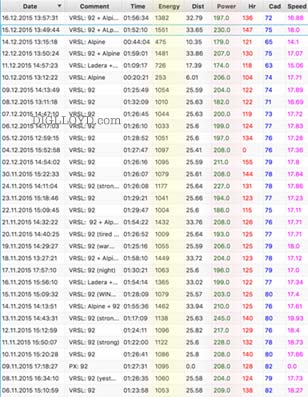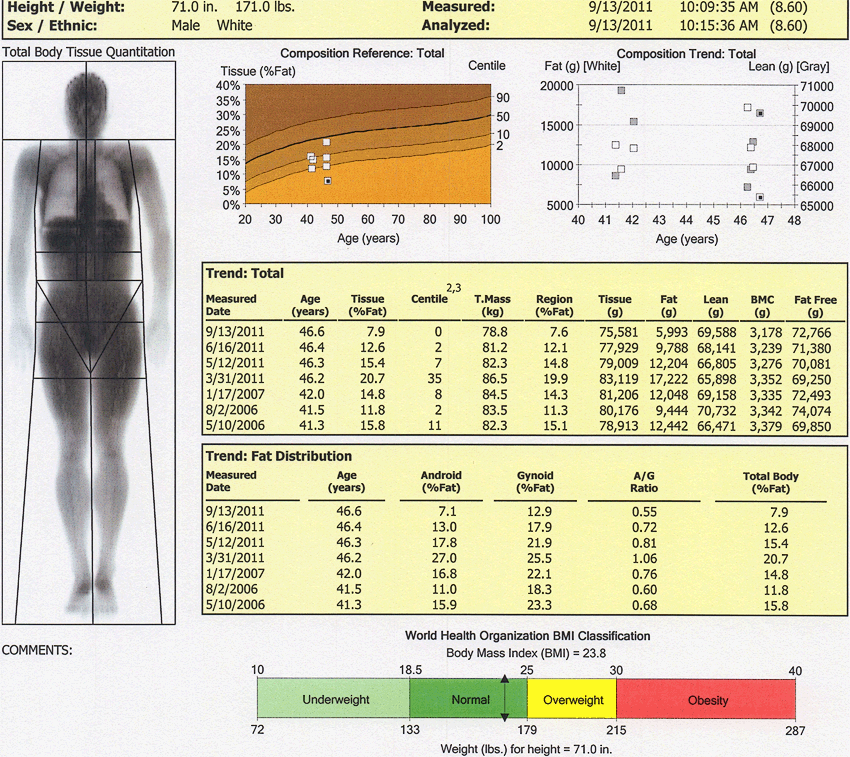Keeping the Pounds Off + Fat Loss, Muscle Mass, Bone Density, Training, BMI, DEXA

Energy = Kilojoules at crankset
I generally ride between 8000 and 12000 miles per year on my bicycle. Even so, I tend to pack on the pounds starting right around the middle of October—seasonal and predictable. This year has not been kind in that regard, even though I’m presently burning about 32,000 kilojoules per week* (7700 kilocalories aka “calories”). I have to work hard at it, darn it. My SRM power meter is accurate and precise to 1%, so those are solid figures.
* 8000 KJ at the crankset as measured by SRM power meter, which accounting for muscle efficiency of ~0.25 as per a highly trained endurance athlete works out to ~32,000 KJ energy requirement, or about 7700 kilocalories (“calories”), which can vary somewhat by intensity, recovery needs, etc.
Much of my focus has been towards “leaning out” for races like the Everest Challenge where one (1) pound of weight can cost up to 6 minutes. But also for any hill climbing including or for double centuries, like Alta Alpina 8-pass. Or grueling mountain bike summitting, because it’s all about power to weight when hill climbing.
So here’ my admittedly geek approach to burning off body fat. Maybe there’s one thing in here that will be of interest to those in the same boat. From my Training and Nutrition sections:
- Training Weight Loss: Tracking Calories (Diet) and Training Weight Loss: Tracking Body Weight as well as Training Weight Loss: Caloric Deficit.
- Training Weight Loss: 2012 Case Study
- For nerds: Understanding Work Efficiency, Kilojoules and Kilocalories
- DEXA Body Scan for Fat, Muscle, Bone Measurement (a pet peeve of mine is the junk science that is BMI, which rates me as overweight a good part of the year). See also DEXA vs BMI.
No matter what, losing body fat is tough. But more and more research suggests that excess body weight/fat can often be blamed at least in part on the gut biome, at least for me (given my intense exercise workload). Also, be exceedingly skeptical of antibiotics as they can be nasty as the FDA is belatedly “discovering” (better late than forever incompetent).
Observe how being in the 0% percentile (!) in 2011 for body fat quickly changes to borderline overweight, just by gaining 9 pounds to 180! Doctors who use BMI as a meaningful metric are incompetent, because the value can be complete garbage for people like me (applying a mass statistical tool of dubious legitimacy to an individual is a fundamental scientific error showing gross ignorance of statistics). When I’m that lean (171 pounds), my bone density and muscle mass are such that with my lungs as full as they will go, I barely float. Exhale, and I plummet to the bottom. That, by the way, is a good test for body mass composition (floating in fresh water) with full lungs and fully exhaled.
Mark C writes:
The depressing thing is that you can fuel 40,000 kilojoules of exercise with 1 kilogram of fat.
DIGLLOYD: 40K kilojoules metabolic cost would means ~10,000 KJ at the crank (assuming a highly trained endurance athlete, see efficiency of muscle conversion). Flip side: not starving to death is really wonderful, if you are not overfed like here in the USA.
But the really crummy deal as that as I’ve done more and more long endurance events, my body has gotten considerably more metabolically efficient: fewer calories used for the same power output.
My double centuries average 6000 to 9500 calories burned (example, 8701 KJ at crank = 34800 KJ metabolic = ~8350 calories). That's my secret weapon to losing fat: ride double centuries. I figure (and actual experience backs it up) that I burn off about 1.5 pounds of fat on a double century. That does not include recovery metabolic costs of course.
About 1/2 of the metabolic cost is aerobic (fat burning) because it is impossible to fuel the body that long with carbs*, or even to assimilate much: the stomach can accept only ~250 calories/hour (less if dehydrated). So in 10 hours I can take in 10 X 200 = 2000 calories of Hammer gel or Hammer Perpetuem or similar. The body burns carbohydrates as well as protein (gluconeogenesis) on long events (10-15% protein). That’s why something like Hammer Perpetuem is advised for long, long rides—it helps keep the body from eating its own muscle tissue.
* For endurance events, carbohydrates and protein are still mostly aerobic, excepting very steep climbing or spurts of power, etc. The issue is that the stomach can take in at most ~250 calories per hour under ideal conditions, so fat has to be the main energy source. Taking myself as an example, for double centuries I expend about 700 calories per hour. For shorter more intense races like the Everest Challenge, it is about 1100 calories per hour on the climbs.



